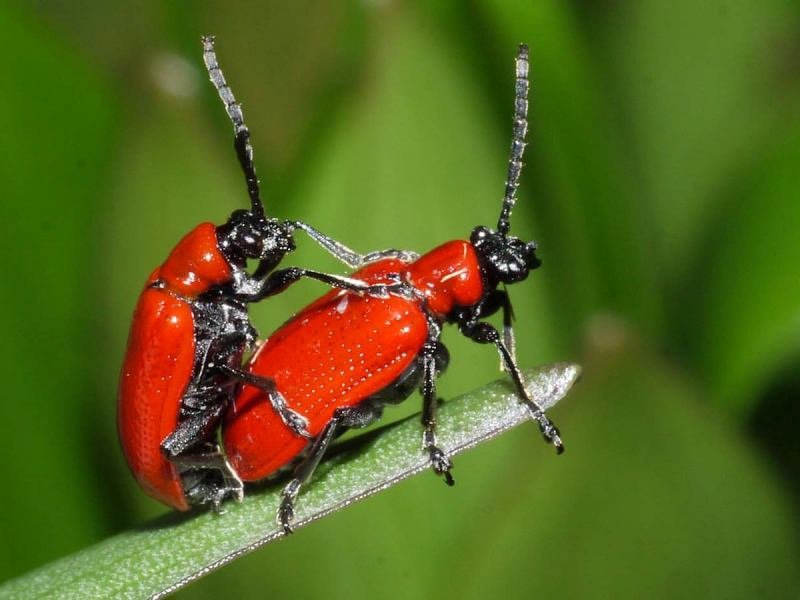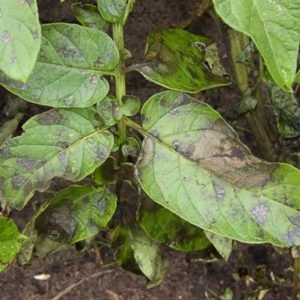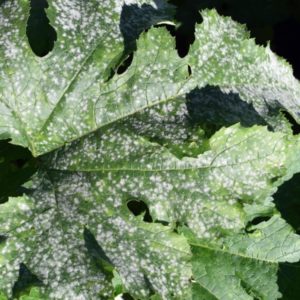The beetle is a well-known pest of our gardens that particularly attacks lilies. It is a small beetle with an elongated body of 8 mm with red elytra bright or orange-red depending on the species, which drops and squeals when you try to grab it. From March, the adult who overwinters in the soil comes to feed on already developed plants.
How to detect the beetle?

In the ornamental garden
The beetles – Lilioceris lilii (black-headed) and L. merdigera (totally red) – are capable of causing great damage to the foliage of Liliaceae. Sensitive plants are especially lilies, the imperial fritillary, Solomon’s seal (Polygonatum) and thrush , to the point of completely annihilating flowering.
In the vegetable garden
The vegetable garden is not spared either, other forms of beetles are present on the asparagus. They also have a rectangular body but their yellow elytra are spotted or punctuated with black and the thorax is red ( Crioceris asparagi and C. duodecimpunctata ). Eliminating the aerial parts of asparagus in the fall helps control them.
Beetle damage
The Madonna lily ( Lilium candidum ) is very often the victim of its attacks. Indeed its foliage has been developed since autumn and allows the adult insect to feed as soon as it comes out of the ground, in March. It perforates the leaf blade. The beetle is then able to chain 2 to 3 generations during the summer which will attack the summer lilies. The damage is detectable from April to September.
The reproduction cycle of the beetle

Each female can lay 200-300 eggs on the stems and the underside of the leaves. The larvae hatch after 10 days. They have around, orange-pink body, a blackhead and are covered with their droppings. They start to devour the blade to the petiole and then the flower buds. At the end of 15 days, they gain the ground to pupate. An adult appears 3 weeks later ready to produce a new generation! When temperatures drop, the adult overwinters in the soil.
How to overcome it?

Careful observation
The sooner you recognize their presence, the easier it will be to get rid of them without the help of treatment. If you have early bulbs like Imperial Fritillary or Madonna Lily, inspect the foliage as early as March. The insects are easily spotted with their bright colors and are easily caught. When they sense danger, they tend to drop to the ground on their backs so as not to be spotted. You just have to come back a little later to surprise them.
Fast action
Damaged lily beetleWhen black clumps appear on the leaves, crush the larvae or run a sponge to remove them. If the invasion is well advanced, treat in the evening with rapeseed oil dosed at 2%, but only on eggs and larvae. Treatment is ineffective in adults.
How to prepare the 2% solution?
Mix 20 ml of rapeseed oil in 1 liter of rainwater (non-calcareous) and add 12 ml of washing-up liquid or black soap.
Shake well before spraying the solution on the foliage above and below.
Repeat 2 weeks later.
This product acts by contact and therefore has no preventive action. Monitor regularly for the presence of orange eggs or larvae covered with excrement on and under the foliage.
The other means of struggle
- The strong-smelling tansy infusion would be effective as a spray on the leaves to deter beetles.
- The plantation near strong-smelling plants such as wormwood or the street would also have a repellent effect.
- Also, consider weeding the bittersweet nightshade that harbors the insect.




